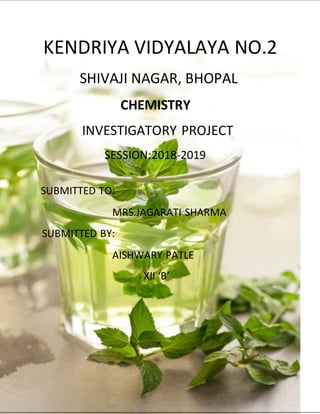
Investigatory project chemistry
- 1. KENDRIYA VIDYALAYA NO.2 SHIVAJI NAGAR, BHOPAL CHEMISTRY INVESTIGATORY PROJECT SESSION:2018-2019 SUBMITTED TO: MRS.JAGARATI SHARMA SUBMITTED BY: AISHWARY PATLE XII ‘B’
- 2. CERTIFICATE: This is to certify that Aishwary Patle , roll.no…………. ,studying in class XII “B” of Kendriya Vidyalaya No.2, Shivaji Nagar, Bhopal (M.P) has completed the chemistry investigatory project under the guidance and supervision of Mrs. Jagrati Sharma (PGT Chemistry) in session 2018-2019. PRINCIPAL TEACHER’S SIGN EXTERNAL
- 3. ACKNOWLEDGEMENT: My sincere thanks to our chemistry teachers Mrs.Jagrati Sharma for providing me all facilities required for the completion of this project and who supported me with gentle co-operation and great patience. I would also like to express my gratitude to our lab assistantMr. Kemchand for his support during making the project. Aishwary Patle XII ‘B’
- 4. INDEX: 1. AIM 2. INTRODUCTION 3. REQUIREMENT 4. THEORY 5. PROCEDURE 6. OBSERVATION 7. RESULT 8. PRECAUTION 9. BIBLIOGRAPHY
- 5. AIM: To compare the water soluble polyphone (catechin) content in the various samples of tea leaves.
- 6. INTRODUCTION: India is a large exporter of tea which is a crash crop. Tea is made from the young leaves and unopened buds of the tea plants camellia. The use of an infusion of dried tea leaves as a beverage has it origin since very ancient times. It was first cultivated in china. Tea leaf is rich in alkaloid caffeine which constitutes as much as 4% of the dry matter in the young leaf. It is the main active ingredient of tea which acts as a stimulant. Besides caffeine, tea leaves contain tannin and colouring matter polyphenolic compounds and some flavouring agents. We can check the presence of all these substances and their relative amounts through sample experiments.
- 7. FACTORS AFFECTING THE QUALITY OF TEA:- The quality of tea depends on the climate and soil. Climate: It is the deciding factor as to which variety of tea can be grown to the best advantage. Change in the climate in the climate affects the quality and flavor of tea and influences the time of maximum seed fall. The tea plants best grow in the season of monsoon land of South East Asia where cool whether if fairly dry with a market fall in temperature. Frost kills the plants if the sum reaches the affected area early in the morning before the leaf has hard time to warm up. To prevent this tea plants are grown under the trees. Soil: Tea plants best grow on light loamy soil. However it can be grown on all types of soil. Potash manure is very good. Nitrogenous manures whether in organic form or chemical form have adverse effect on the quality of the tea. Since soils contain such readily available Aluminum and Magnese which the tea bush consumes and stores in relatively large amounts, it is the need for these elements that necessitates an acid soil for the growth of tea.
- 8. TYPES OF TEA: TEA IN India is of two types:- 1. The Chinery type tea grows in and around Darjeeling and yields a rich flavor. 2. The Assam type tea grows in the plants of Assam and West Bengal and yields strong and bright liquored tea. 3. Aroma(smell) of tea: six hours after the leaf has been plucked, the rapid development of asparagine’s takes place, irrespective of whether physical withering has begun or not. Most of the development of aroma takes place during fermentation and reaches its optium stage in about 3 and half hours. The main constituents responsible for aroma are: >Caffeine >Polyphenol >amino acid >Magnese and other inorganic materials
- 9. REQUIREMENT: 1. Beaker 2. Conical Flask 3. Funnels 4. Heating Arrangement 5. Tea bags of different brands of tea
- 10. PRINCIPLE: Water soluble polyphenol are present up to 30%.They are very much soluble in water largely responsible for the aroma (smell), color and quality of tea samples.
- 11. THEORY: Tea contains up to 30% of the water soluble polyphenol (catechin). These are largely soluble in responsible for the extent of these compounds in a given sample, the tea leaves are immersed in hot water for equal time and the loss in the weight of tea leaves is determined.
- 12. PROCEDURE: 1. Weigh exactly 5g of the different samples of tea and place them in tea bags. 2. Take three or four conical flasks and put 100ml of hot water to each of them. 3. Put tea bags of different samples of tea in the different conical flasks. After 10 minutes remove the bags and dry them by placing in an oven. 4. When tea bags become dry, reweight them. 5. Note the flavor of the tea solution obtained.
- 13. OBSERVATION: s.no Brand Name of Tea Initial Weight [X g] Final Weight Loss of weight [Y g] % of water Soluble Component= Y/X 1. 2. 3. 4.
- 14. RESULT: The polyphenol content is more in ………………………. The polyphenol content is more in the tea which gives the better flavor.
- 15. PRECAUTIONS: 1. Students should wear lab coat. 2. Handle apparatus with care. 3. Do not touch beakers while heating. 4. Do not use large amount of substance. 4. Never taste anything. 5. Wash your hands before leaving the lab.
- 16. BIBLIOGRAPHY: 1. WIKIPEDIA.COM 2. GOOGLE SEARCH ENGINE 3. CHEMISTRY COMPREHENSIVEMANUAL OF CLASS XII